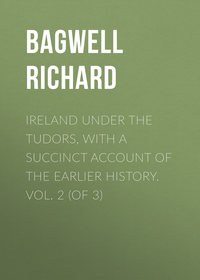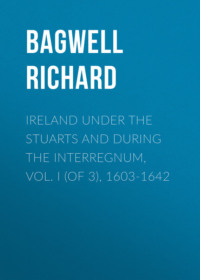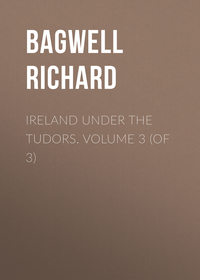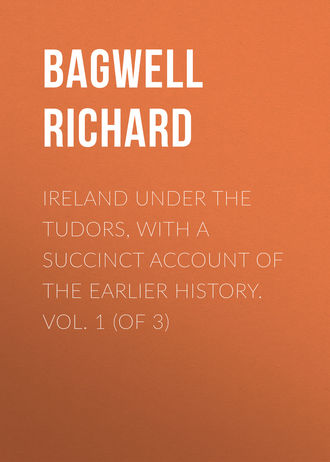 полная версия
полная версияIreland under the Tudors, with a Succinct Account of the Earlier History. Vol. 1 (of 3)
254
The session was from Feb. 15 to March 7 or 10; see Lord Deputy in Council to the King, March 31, 1542; for the robbers, see same to same, Nov. 25, 1544.
255
See the submissions in Carew– MacBrien Coonagh, March 18, 1542; Rory O’More, May 13; MacQuillin, May 18; MacDonnell, May 18; Hugh O’Kelly, May 24; O’Byrnes, July 4; O’Rourke, Sept. 1; MacQuillin and O’Cahan, May 6, 1543. Lord Deputy and Council to the King, July 12, 1542, and Aug. 24.
256
Desmond’s visit to Court was between June 2 and July 5, 1542. Lord Deputy and Council to the King, June 2; J. Alen to the King, June 4; the King to the Lord Deputy and Council, July 5; St. Leger to the King, Aug. 27.
257
Indentura facta 26 die Septembris, 1542, in S.P. The signatories promised jointly and severally ‘usurpatam primatiam et auctoritatem Romani Episcopi annihilare, omnesque suos fautores, adjutores, et suffragatores, ad summum posse illorum precipitare et abolere … omnes et singulos provisores … apprehendere et producere ad Regis communem legem,’ &c.
258
Lord Deputy and Council to the Privy Council, Sept. 1, 1542; Four Masters, 1542.
259
Submission made at Greenwich, Sept. 24, 1542.
260
The creation was Oct. 1, 1542. The patent is in Rymer; the Herald’s account in Carew, Oct. 1. O’Neill was back in Ireland before Dec. 7, when the Irish Government wrote of him to the King. Tyrone’s style was – ‘Du treshaut et puissant Seigneur Con, Conte de Tyrone, en le Royaulme d’Irlande.’
261
The heraldic account is printed in S.P., vol. iii. p. 473, from the Cotton MSS.; the O’Brien and Burke patents are in Rymer, Conatius being by mistake printed for Donatus; see the King to the Lord Deputy and Council, July 9, 1543; MacWilliam submitted much in the same terms as O’Neill.
262
Hill’s MacDonnells of Antrim, chaps. i. and ii.; Archdall’s Lodge’s Peerage, Earl of Antrim and Baron MacDonnell; Burton’s History of Scotland, vol. iii. p. 149. For the antiquarian controversy in 1617, see Carew, vol. vi., Nos. 183, 188, 189, 190. 191.
263
Hill, p. 37; John Travers’s Devices in S.P., vol. iii. p. 382.
264
Hill, p. 41; St. Leger to the King, June 4, 1543; Lord Deputy and Council to the King, June 5.
265
St. Leger to the King, July 18, 1543, and the notes; see also Carew, July 15 and 16.
266
Lord Deputy and Council to the King, May 15, 1543; same to same, Dec. 7, 1542, and the King’s answer.
267
St. Leger to the King, April 6, 1543; the King to the Lord Deputy and Council, Aug. 9; Lord Justice Brabazon and Council to St. Leger, March 24, 1544.
268
Lord Justice Brabazon and Council to the King, May 7, 1544; same to St. Leger, March 24, where the kerne are first mentioned in the S.P.; Privy Council to Lord Justice and Council, March 30; Ormonde to the King, May 7. In a letter to the King printed in S.P., vol. iii., No. 437, O’Reilly complains that his contingent cost him 600l., that eight weeks of their wages remained unpaid, and that his chaplain had been taken prisoner in Scotland, and had paid eight nobles for his ransom. This shows that some of the 1,000 kerne went to Scotland.
269
Stanihurst.
270
For these rumours, see the S.P. from May 20, 1544, till May 11, 1545, vol. iii., Nos. 407, 408, 411, 414, 415.
271
St. Leger to Wriothesley, Feb. 26, 1545, with Lord Upper Ossory’s letter in a note; to the Privy Council, April 14.
272
Hill, p. 43. In a letter printed in S.P., vol. v. p. 483, Donnell Dhu speaks of himself as ‘in materno utero inimicorum jugo et captivitati astricti, et in hoc pene tempus carceris squalore obruti, et intolerabilibus compedibus truculentissime ligati.’ The notarial instrument between the islemen is in S.P., vol. v. p. 477. Lord Deputy and Council of Ireland to the King, Aug. 13, 1545.
273
Privy Council to Lord Deputy and Council of Ireland, in S.P., vol. iii., No. 422. See S.P., vol. v. pp. 505-7.
274
Ormonde to Russell, Nov. 15, 1545; Lord Deputy and Council to the King, Nov. 19. Donnell Dhu died before Jan. 20, 1546, the date of a letter from James MacDonnell in S.P., vol. iii. p. 548. Dowling.
275
Lord Deputy and Council to the Privy Council, Feb. 15, 1546, and a letter in a note from ‘Ewyne Allane of Locheld.’ James MacDonnell is called Lord of the Isles ‘by consent of the nobility,’ ‘apparent heir,’ ‘worthy to succeed,’ and ‘Lord elect.’
276
Ormonde to Russell, Nov. 15, 1545.
277
Cusack to Paget, March 28, 1546. See the S.P. from Feb. 20 to March 28, vol. iii., Nos. 431, 433, 434, 435, 438, 439, and 440.
278
See S.P. 1546, vol. iii., Nos. 441 to 448. No. 439 is a letter from certain Irish chiefs to the King in St. Leger’s favour, and they make the reflection, ‘Oh si majoribus nostris tales contigissent moderatores.’
279
Alen’s Answer to St. Leger in S.P., vol. iii. No. 446, and W. Cowley’s Letter to the Privy Council, No. 448; Alen to Paget, April 21, 1549; St. Leger to Cecil, Dec. 5, 1550.
280
Stanihurst; Morrin’s Patent Rolls, p. 168.
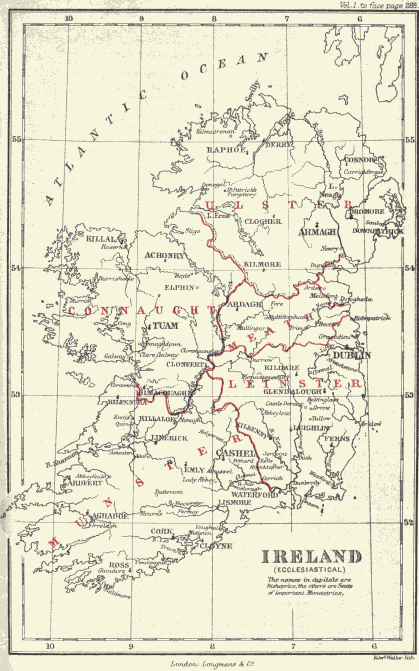
281
Surrey to Wolsey, Sept. 6, 1520, and the notes; Pace to Wolsey, April 7, 1521, in Carew; Stubbs, Const. Hist. ii. 317.
282
Ware’s Bishops; Richard Culoke to Brabazon, Nov. 10, 1537; the King to the Lord Deputy and Council, July 10, 1543.
283
Ware.
284
Brady’s Episcopal Succession, vol. i. p. 325; Ware. Roy’s satire against Wolsey, printed in the 9th vol. of the Harleian Miscellany, has the following:
Wat. And who did for the show pay?Jeff. Truly many a rich abbayeTo be eased of his visitation.Wat. Doth he in his own person visit?No, another for him doth it,That can skill of the occupation.A fellow neither wise nor sad,But he was never yet full mad,Though he be frantic and more.Dr. Alen he is named,One that to lie is not ashamedIf he spy advantage therefore.Wat. Are such with him in any price?Jeff. Yea, for they do all his advice,Whether it be wrong or right.285
As to the legatine authority, see Brewer, vol. iii., No. 2838, and iv., No. 5131; John Alen to Wolsey, June 1, 1523, in S.P.
286
Clement VII. to Henry VIII., Oct. 21, 1524, in Brewer and in Rymer; Kildare’s Articles against Ormonde in S.P., vol. ii. p. 123; and see Brewer, vol. iv., No. 4277; R. Cowley to Wolsey in 1528, S.P., vol. ii. p. 141; Presentments of Grievances, edited by Graves, p. 203; Council of Ireland to Cromwell, Feb. 8, 1539.
287
Brady, vol. ii.; Council of Ireland to Cromwell, Feb. 8, 1539.
288
Theiner’s Vetera Monumenta, pp. 515, 516, 521; Brady, Arts, Kilmore, Clogher, and Raphoe.
289
Kildare to Wolsey, Feb. 8, 1522; R. Cowley to Wolsey, S.P., vol. ii., No. 53; Ware.
290
For the Ross case, see Theiner, p. 520; for the union of Ross and Dromore ‘propter tenuitatem utriusque ecclesiæ,’ see Brady, vol. ii. p. 109.
291
See Brady, under Elphin and Kilmacduagh.
292
S.P., vol. ii. pp. 11, 15, and 16.
293
For Ardagh, see Theiner, p. 521; for Ross, p. 529; for Clonmacnoise, p. 518. For Enaghdune, see Ossory to Cromwell in 1532, Carew, vol. i. No. 37.
294
Presentments of Grievances, ed. Graves; particularly pp. 192 and 203.
295
Kildare’s Articles against Ormonde in 1525, S.P., vol. ii. p. 123; his statement is partially confirmed by the Presentments of Grievances, and see Ossory’s own statements in 1534, Carew, vol. i. p. 55; Ware’s Life and Death of Archbishop Browne.
296
Indenture of Remembrance for the Earl of Ossory and Lord Butler, May 31, 1534, in Carew; Presentments of Grievances, pp. 48 and 204; Four Masters, 1525; Dowling’s Annals, 1522: – ‘Mauritius Doran episcopus in jocando ejus adventu quibusdam persuadentibus duplicari subsidium cleri respondit: melius radere oves quam destruere.’
297
Presentments of Grievances, especially pp. 100, 202, 204, and 248; for the sons of clergy, &c., see Kildare’s Articles in S.P., vol. ii. p. 122. In Brewer, Feb. 25, 1521, Leo X. authorises a priest’s son to govern the Cistercian Abbey of Rosglas; Browne to Cromwell, Nov. 6, 1538, in S.P.; for Kilclehin (wrongly calendared as Kilcullen), see Hamilton, Oct. 9, 1539.
298
For the educating monasteries, see Lord Deputy and Council to Cromwell, May 21, 1539, and the petition from St. Mary’s, July 31. The value of the friars appears from the whole history of the time. See in particular Presentments of Grievances, p. 130; R. Cowley to Cromwell, Oct. 4, 1536.
299
Browne to Cromwell, July 15, 1536 (?), in Browne’s Life and Death, in Ware, p. 148, and in the Phœnix; R. Cowley to Cromwell, Oct. 4, 1536.
300
Browne to Cromwell, Jan. 8, May 8, and Aug. 10, 1538. The Form of the Beads in S.P., vol. ii., No. 214; R. Cowley to Cromwell, July 19, 1538 and Aug. 5.
301
James White to Cromwell, March 28; Lord Butler to the King, March 31; again to Cromwell, April 5; Brabazon to Cromwell, April 30; Browne to Cromwell, Jan. 8, May 8 and 20, 1538.
302
This quarrel may be traced in detail in the State Papers. Browne to J. Alen, April 15, 1538; to Cromwell, May 8 and 21, and June 20 and 27; Staples to St. Leger, June 17; to Cromwell, June 10 and Aug. 10; Thomas Alen to Cromwell, Oct. 20; Brabazon to Cromwell, April 30.
303
Grey to Cromwell, Dec. 31, 1537; J. Alen to Cromwell, Oct. 20, 1538; Browne’s Letters in S.P. from 1538 to 1540; R. Cowley to Cromwell, July 19, 1538; Lord Butler to Cromwell, Aug. 26. Butler says that at the Lord Deputy’s table the vicar of Chester said the King had commanded images to be set up, worshipped, and honoured as much as ever. ‘We held us all in silence to see what the Lord Deputy would say thereto. He held his peace, and said nothing; and then my Lord of Dublin, the Master of the Rolls, and I said that if … he were out of the Deputy’s presence, we would put him fast by the heels… His lordship said nothing all the while. Surely he hath a special zeal to the Papists.’ For Down Cathedral, see Stanihurst.
304
Ware places the destruction of relics in 1538: it was perhaps a little later. For Our Lady of Trim and the Baculum Jesu, see the Four Masters, under 1537, and O’Donovan’s notes; also Giraldus Cambrensis, Top. Dist. iii. cap. 33 and 34, and Expug. lib. ii. c. 19, Record Edition. The notice in Campion is perhaps only an echo of Giraldus.
305
The above paragraph is founded on a careful comparison of the data in Ware, Cotton, and Brady. R. Cowley to Cromwell, Aug. 5, 1538; and see S.P., vol. iii. pp. 110, 117, and 123. A letter from Staples to St. Leger, June 17, 1538, throws some light on Henry’s relations with Rome before the divorce question arose: ‘Appoint some means how that such bishops as had their bulls of the Bishop of Rome by our sovereign lord’s commandment may bring in their bulls, cancelling the same, and to have some remembrance from his Highness, which shall stand them in like effect with the same.’
306
There are notices of Wauchop in Ware, Brady, Sarpi, ii. 34 (French translation and Courayer’s notes), and Moran’s Spicilegium Ossoriense, vol. i. p. 13. Twelve letters of Wauchop printed in the last-named work have nothing particular to do with Ireland. He must be regarded as founder of the titular hierarchy in Ireland.
307
Abstracted from Hogan’s Hibernia Ignatiana, p. 4, where Paul’s letter may be also read in the original Latin.
308
Hogan’s Hibernia Ignatiana, pp. 3-9. Paul III.’s letter to Con O’Neill is dated April 24, 1541. The Jesuits were in Ireland in February and March, 1542. O’Sullivan Beare, lib. iii. cap. 8. James V. to the Irish chiefs, in S.P., vol. v. p. 202; Paget to Henry VIII. from Lyons, July 13, 1542, in S.P., vol. ix. p. 106.
309
Calendar of Patent Rolls, p. 73; Grey to Cromwell, Feb. 4, 1537. The last session began Oct. 13, 1537; a detailed account is given by Brabazon in a letter to Cromwell in S.P., vol. ii. p. 524, and in the note there.
310
Grey and Brabazon to Cromwell, May 18, 1537. The King to the Lord Deputy and Council, S.P., vol. ii. p. 425. Harris’s Ware under Staples, Bishop of Meath. For the names of the dissolved houses, see the Statute, 28 Henry VIII. cap. 16, and Calendar of Patent Rolls, p. 38. There were twenty-five mitred abbots and priors in Ireland, ten of Canons Regular, one of Benedictines, one of Hospitallers, and thirteen of Cistercians. Ware, in his Annals, says the heads of St. Mary’s and St. Thomas’s, Dublin, of Kilmainham, and of Mellifont were regularly summoned to Parliament – the more distant ones very seldom. The Augustinians were the most numerous and probably the richest of the sedentary orders. Their rule was adopted by most of the ancient Irish monasteries, the small residue becoming Benedictine. Alemand, who was originally a Huguenot and who was Voltaire’s countryman, remarks that in order to become quickly a bishop in Ireland, it was necessary first to be a Regular Canon.
311
Chiefly from Alemand; the words of John’s grant are ‘ante adventum Francorum in Hiberniam.’ For the final grant, see Archdall’s Lodge. Art. Earl of Drogheda.
312
Alemand. Sidney to Queen Elizabeth, April 20, 1567, in the Sidney Papers.
313
Alemand and Archdall. As to the intended combat, see Carew, miscellaneous vol., pp. 446, 447.
314
Most of the pensions mentioned in the text are traceable in Morrin’s Calendar of Patent Rolls. For Cahir, see Archdall’s Monasticon. Queen Mary’s instructions to Lord Fitzwalter, April 28, 1556, in Carew.
315
Alemand, passim; Documents in the supplementary volume of King’s Primer, No. 66; the Waterford document is in Brennan’s Ecclesiastical History, p. 459.
316
Sir John Davies’s Discovery.
317
In Mant’s Church History is an estimate of the monastic property founded on the Loftus MS.; but such calculations must be very rough. R. Cowley to Cromwell, Oct. 4, 1536.
318
Agard to Cromwell, April 4, 1538. James White to Cromwell, March 28. Spicilegium Ossoriense, vol. i. p. 437. Hibernia Dominicana.
319
In recommending a grant of Dusk to Ormonde the Council say they ‘cannot perceive, as it is situated, that any man can keep it for the King, but only the said Earl or his son.’ For Toem and Dunmore, see Calendar of Patent Rolls, pp. 73 and 84. Browne to Cromwell, May 21, 1538.
320
Ware’s Antiquities, by Harris, chap. xxxvii., sec. 3. Lord L. Grey to Cromwell, Jan. 19, 1538.
321
The King to Browne in S.P., vol. ii. p. 174; Browne’s answer, Sept. 27, 1537; Staples to St. Leger, June 17, 1538; Ware’s Life and Death of Browne.
322
Ware’s Bishops; Staples to St. Leger, June 17, 1538; Devices by Travers for the Reformation in 1542, S.P., vol. iii., No. 382. The King’s rebuke was in 1537, see S.P., vol. ii. p. 174, note.
323
Lord Protector and Privy Council to Lord Deputy St. Leger and Council, March 25, 1547; the King to the same, April 7; King Edward VI. to the Earl of Desmond, Oct. 6. In a letter dated Lambeth, July 6, to her ‘assured loving friend Mr. Cecil, Master of Requests,’ Lady Ormonde begs that Abbeyleix may not be granted to Barnaby Fitzpatrick to her son’s detriment, and she refers to Cecil’s ‘former friendship.’ Here we see the beginning of a most important connection.
324
Four Masters, 1546, 1547.
325
Introduction to Carew, vol. ii. p. lxxxv.; Archbishop Butler to the Lord Protector, Feb. 25, 1548; Calendar of Patent Rolls, p. 154.
326
Calendar of Patent Rolls, p. 66. For Butler and Powell, see three letters calendared under April and May 1548, Nos. 16, 17, and 19.
327
Privy Council to Lord Deputy and Council, Nov. 2, 1547; John Brereton to Bellingham, May 1548 (No. 20), and July (Nos. 44 and 45); Cosby to Bellingham, July (Nos. 48 and 50). Bellingham dated a letter from Athy, Aug. 19, 1548. The eighteen beds are mentioned by John Plunket and Thomas Alen in a letter to him of the 18th.
328
Lord Dunboyne to Bellingham, June 21, 1548, and the answer (No. 25).
329
Sovereign and Council of Kinsale to Bellingham, July 15, 1548; Mayor, &c., of Cork to same, July 24, Aug. 27, Dec. 29, and the answer, Jan. 10, 1549; Mayor, &c., of Waterford to Bellingham, Sept. 5, 1548.
330
Mayor, &c., of Youghal to Bellingham, July 8, 1548; Deputy Mayor and Council of Galway to same, Aug. 13; Bellingham to Limerick, Aug. (No. 63); John Goldsmith to Bellingham, Aug. 22; Kyng to Wyse, Sept. 5. Sir Philip Hoby’s letter is calendared among the foreign S.P., April 17, 1549.
331
Bellingham to Alen, July 1548 (No. 39); Mayor, &c., of Drogheda to Alen, Aug. 8; Bellingham to Privy Council, Aug. (No. 84), and to the Mayor of Dublin (No. 67). For the fort, which became Maryborough, see the notes to O’Donovan’s Four Masters under 1548 and 1553.
332
Bellingham to the Privy Council, Aug. 1548 (No. 84).
333
Bellingham to the Mayor of Cork, Aug. 1548 (No. 80); Mayor, &c., of Cork to Bellingham, Nov. 18; Alen to Somerset, Nov. 21; Bellingham to Arthur, Dec. (No. 145).
334
Archbishop Bodkin to Bellingham, July 25, 1548; Bellingham to Richard Burke, Aug. (No. 83), and to the Mayor of Limerick, Sept. 18; Ulick Burke to Bellingham, Sept. 22.
335
Four Masters, 1548 and 1549.
336
Alen to Paget, Nov. 21, 1548.
337
Harris’s Ware, pp. 211-217; S.P., vol. iii. p. 534; Four Masters, 1546; Mayor, &c., of Galway to Bellingham, July 27 and Aug. 13, 1548; Sovereign and Council of Kinsale to same, July 16; Agard to same, Sept. 23; Richard Brasier to same, Oct. 8; Memoranda by Bellingham, Nov. 14; Bellingham to Warwick, November (No. 132, i.); Privy Council to Bellingham, Jan. 6, 1549.
338
Bellingham to Somerset, Nov. 22, 1548, which encloses a copy of the letter to Warwick; to Issam, Dec. (No. 163).
339
Bellingham to O’Molloy, Nov. 24, 1548; to O’Carroll (No. 138); to Thomond (No. 137).
340
Alen to Paget, April 1549 (No. 32).
341
Bellingham to John Issam, Nov. 1548 (No. 140). Hooker’s Chronicle in Holinshed. The capture of Desmond was about Christmas 1548.
342
Richard Brasier to Somerset, Nov. 14, 1548; John Moorton to same, April 15, 1549; Anthony Colcloght to same, Feb. 1 and 13, and to Cahir MacArt, Jan. 27; Walter Cowley to Bellingham, March 14; Brian Jones to same, April (No. 35).
343
Staples to – between Dec. 22 and 29, 1548. The letter is not addressed to Bellingham, but he must have seen it, as it is endorsed by his clerk. See also Walter Palatyne to Bellingham, Nov. 23, 1547, and Interrogatories for Archbishop Browne at the end of that year. The first Book of Common Prayer was not printed till 1550.
344
Bellingham to Dowdall, Dec. 1548; John Issam to Bellingham, Dec. 22; Richard Brasier to Somerset, Nov. 14.
345
Sovereign of Kilkenny to the Lord Deputy, April 26, 1549; Walter Cowley to same, June 25; Brasier to Somerset, Nov. 14, 1548; John Brereton to Bellingham, 1548 (No. 174).
346
Book of Howth; Ware; Hooker in Holinshed; Lodge’s Patentee Officer in Liber Hiberniæ. Bellingham embarked at Howth, Dec. 16, 1549.
347
Patrick Fraser Tytler’s England under Edward VI. and Mary. He quotes Melville’s Memoirs. See in particular the letter of Sir John Mason to the Privy Council, June 16, 1550. The ‘Loch’ mentioned by Melville must be Lough Foyle or Lough Swilly.
348
Instructions from Lord Chancellor Alen to Thomas Alen, Feb. 1550. Bryan died, Feb. 2, 1550.
349
Lord Chancellor and Council to Tyrone, March 17, 1550: – ‘Tam ferox est illius nationis nobilitas ut sub Turcâ (quantumvis barbaro) mitius viveres quam sub illorum regimine … summo conatu libertatem patriæ, sanguinis libertatem et personæ vestræ dignitatem abolebunt.’ Dowdall to Alen, March 22; Brabazon to the Privy Council, March 26, with enclosures.
350
Sir John Mason to the Privy Council, June 14, 1550; Foreign Calendar and Fraser Tytler, ut supra.
351
Letters of Croft and the two Bagenals, July 31, 1551; Alen to Cecil, April 5, 1551, and to the Privy Council, Aug. 10. The grant is calendared after the latter date. Having been chief of the commission for the dissolution of abbeys, Alen thought it prudent to go to England during Mary’s reign, but made his peace, became again a member of Council, and lived to congratulate Cecil on becoming once more Secretary of State.
352
Instructions to Lord Deputy St. Leger, July 1550; Mr. St. Leger’s Remembrances for Ireland, same date. He was sworn in on Sept. 10.
353
Instructions to St. Leger; Barbaro’s ‘Report on England’ in 1551, in the Venetian Calendar.
354
St. Leger to the Lord High Treasurer, Sept. 27, 1550; Henry Wise and John Moorton, officers at Fort Protector, to Bellingham, Jan. 6, 1549; Articles for an expedition into Ireland, Jan. 7, 1551; St. Leger to Somerset, Feb. 18; Privy Council to Lord Deputy and Council, Jan. 26.


